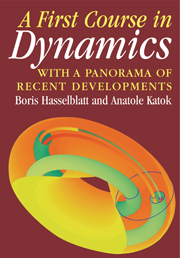Book contents
- Frontmatter
- Contents
- Preface
- 1 Introduction
- PART 1 A COURSE IN DYNAMICS: FROM SIMPLE TO COMPLICATED BEHAVIOR
- PART 2 PANORAMA OF DYNAMICAL SYSTEMS
- 9 Simple Dynamics as a Tool
- 10 Hyperbolic Dynamics
- 11 Quadratic Maps
- 12 Homoclinic Tangles
- 13 Strange Attractors
- 14 Variational Methods, Twist Maps, and Closed Geodesics
- 15 Dynamics, Number Theory, and Diophantine Approximation
- Reading
- APPENDIX
- Hints and Answers
- Solutions
- Index
9 - Simple Dynamics as a Tool
Published online by Cambridge University Press: 05 June 2012
- Frontmatter
- Contents
- Preface
- 1 Introduction
- PART 1 A COURSE IN DYNAMICS: FROM SIMPLE TO COMPLICATED BEHAVIOR
- PART 2 PANORAMA OF DYNAMICAL SYSTEMS
- 9 Simple Dynamics as a Tool
- 10 Hyperbolic Dynamics
- 11 Quadratic Maps
- 12 Homoclinic Tangles
- 13 Strange Attractors
- 14 Variational Methods, Twist Maps, and Closed Geodesics
- 15 Dynamics, Number Theory, and Diophantine Approximation
- Reading
- APPENDIX
- Hints and Answers
- Solutions
- Index
Summary
INTRODUCTION
Applications of the Contraction Principle
The collection of simple dynamical systems with complicated orbit structure presented in Chapter 7 and revisited in Section 8.3 is representative of hyperbolic dynamical systems. Much of the core theory of hyperbolic dynamics consists of results that are obtained (more or less) directly from the Contraction Principle, which first appeared as an example of a dynamical system with simple dynamics in Chapter 2. Although we already used it in Section 2.5 as a tool that can tell us much about other dynamical systems, its pervasive role in hyperbolic dynamics motivates a more thorough presentation of its uses. Accordingly, the main theme of this chapter is to present case studies of using the Contraction Principle, that is, of putting one important insight about a specific class of simple dynamics to use in an auxiliary space to tell us about analysis as well as (complicated) dynamical systems. Since the results we obtain are rather important, we take some time to develop them further, notably when it comes to the basic theory of differential equations. In this chapter we maintain the same standard of proof as in the course.
As in the preceding chapters, this intrinsically interesting development has a utilitarian undercurrent. The results obtained here are important for the study of dynamical systems. In the case of existence and uniqueness of solutions of differential equations this is evident, but all other results presented here also figure in our development and are standard tools in dynamics.
- Type
- Chapter
- Information
- A First Course in Dynamicswith a Panorama of Recent Developments, pp. 259 - 278Publisher: Cambridge University PressPrint publication year: 2003



